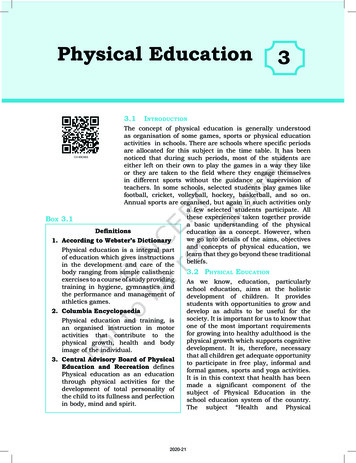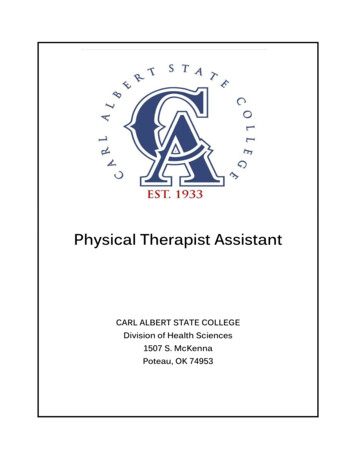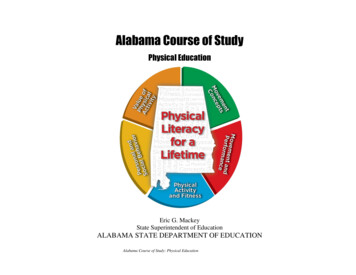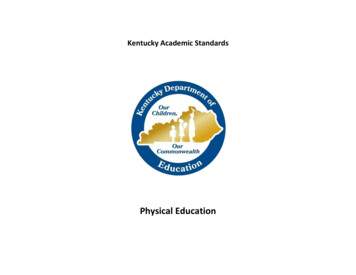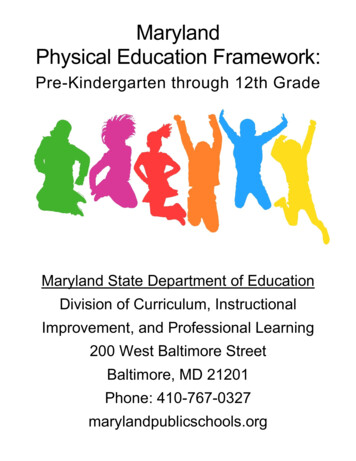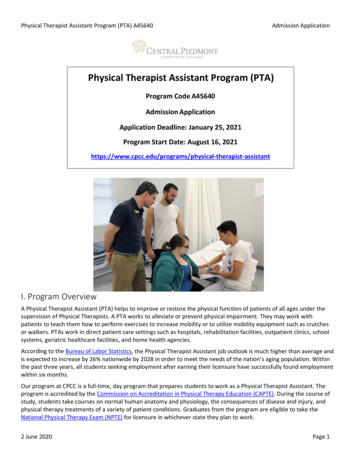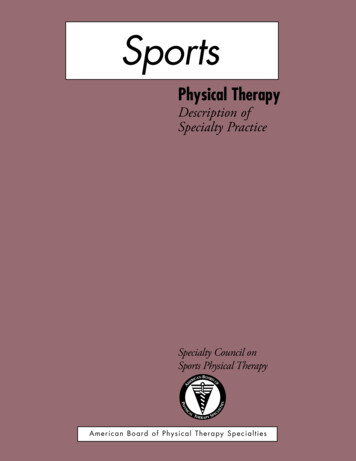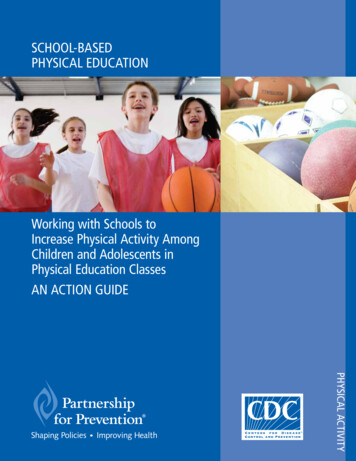
Transcription
SCHOOL-BASEDPHYSICAL EducationWorking with Schools toIncrease Physical Activity AmongChildren and Adolescents inPhysical Education ClassesAn Action GuidePhysical Activity
This publication was developed and produced with funding fromthe Centers for Disease Control and Prevention (CDC) under cooperative agreementU58CCU322077. Its contents are solely the responsibility of the authors and do not necessarilyrepresent the official views of the Centers for Disease Control and Prevention.Centers for Disease Control and PreventionNational Center for Chronic Disease Prevention and Health PromotionDivision of Adult and Community HealthSteps Program4770 Buford Highway, NE, Mailstop K-93Atlanta, GA 30341PHONE: 770.488.6452 FAX: 770.488.8488 E-MAIL: nccdodsteps@cdc.govhttp://www.cdc.gov/stepsThis publication and the other titles in The Community Health Promotion Handbook are availableon the Internet to download or order at http://www.prevent.org/actionguides. Diabetes ManagementDiabetes Self-Management Education (DSME): Establishing a Community-Based DSME Programfor Adults with Type 2 Diabetes to Improve Glycemic Control —An Action Guide Physical ActivityPlaces for Physical Activity: Facilitating Development of a Community Trail and PromotingIts Use to Increase Physical Activity Among Youth and Adults—An Action Guide School-Based Physical Education: Working with Schools to Increase Physical Activity AmongChildren and Adolescents in Physical Education Classes—An Action GuideSocial Support for Physical Activity: Establishing a Community-Based Walking Group Program toIncrease Physical Activity Among Youth and Adults—An Action GuideTobacco-Use TreatmentHealthcare Provider Reminder Systems, Provider Education, and Patient Education: Workingwith Healthcare Delivery Systems to Improve the Delivery of Tobacco-Use Treatment to Patients—An Action GuideSuggested citationPartnership for Prevention. School-Based Physical Education: Working with Schoolsto Increase Physical Activity Among Children and Adolescents in Physical Education Classes—An Action Guide. The Community Health Promotion Handbook: Action Guides to ImproveCommunity Health. Washington, DC: Partnership for Prevention; 2008.April 2008(Updated April 2009)
SCHOOL-BASED PHYSICAL EducationWorking with Schools to IncreasePhysical Activity Among Children andAdolescents in Physical Education ClassesAn Action GuidePartnership for Prevention is a nonprofit organization dedicated to preventing illness and injuryand promoting health. Partnership’s programs reach policy makers, a wide range of public healthand healthcare professionals, businesses, and others who can emphasize prevention.Partnership for Prevention 1015 18th Street, NW, Suite 300Washington, DC 20036PHONE: 202.833.0009 FAX: 202.833.0113http://www.prevent.org
Project Advisory CommitteePartnership for Prevention expresses sincere appreciation to the members of its Project AdvisoryCommittee for their expert guidance in developing The Community Health Promotion Handbookand for their ongoing support of the organization. The Committee’s time and expertise contributedsignificantly to the vision and content of this publication.Georges C. Benjamin, MD, FACP, ChairMichelle Kegler, DrPH, MPHExecutive DirectorAmerican Public Health AssociationDeputy DirectorEmory Prevention Research CenterAssociate ProfessorRollins School of Public HealthEmory UniversityThe Honorable Roderick L. BrembySecretaryKansas Department of Health and EnvironmentNed Calonge, MD, MPHAmy Friedman Milanovich, MPHChief Medical OfficerColorado Department of Public Health andEnvironmentDeputy DirectorAllies Against AsthmaCenter for Managing Chronic DiseaseUniversity of MichiganLarry Cohen, MSWMarcus Plescia, MD, MPHExecutive DirectorPrevention InstituteJonathan E. Fielding, MD, MPH, MBADirector and Health OfficerLos Angeles County Department of Public HealthPaul K. Halverson, DrPH, MHSADirector and State Health OfficerArkansas Department of HealthTom Kean, MPHExecutive DirectorC-ChangeChiefChronic Disease and Injury SectionNorth Carolina Division of Public HealthStephanie Zaza, MD, MPHCaptain, U.S. Public Health ServiceStrategy and Innovation OfficerCoordinating Center for Terrorism Preparedness andEmergency ResponseSteps Program Director (2003–2006)National Center for Chronic Disease Prevention andHealth PromotionCenters for Disease Control and PreventionContributorsPartnership for Prevention recognizes the following individuals who contributed extensive knowledgeand expertise as key informants and reviewers of School-Based Physical Education: Working with Schoolsto Increase Physical Activity Among Children and Adolescents in Physical Education Classes—An ActionGuide, one of five Action Guides that make up The Community Health Promotion Handbook.Kymm Ballard, MAErica Barrett, MOT, MBAPhysical Education ConsultantNorth Carolina Department of Public InstructionThe Ginn GroupSteps ProgramDivision of Adult and Community HealthNational Center for Chronic Disease Prevention andHealth PromotionCenters for Disease Control and PreventioniiSchool-Based Physical Education
Charlene R. Burgeson, MAErica L. Odom, MPHExecutive DirectorNational Association for Sport and Physical EducationEducation Program SpecialistResearch Application BranchDivision of Adolescent and School HealthNational Center for Chronic Disease Prevention andHealth PromotionCenters for Disease Control and PreventionKaren Cowan, MSCoordinator of Fitness and HealthK-12 Student ActivitiesSpokane Public SchoolsAlyssa Easton, PhD, MPHSteps Program DirectorDivision of Adult and Community HealthNational Center for Chronic Disease Prevention andHealth PromotionCenters for Disease Control and PreventionJacqueline N. Epping, MEdHealth ScientistPhysical Activity and Health BranchDivision of Nutrition, Physical Activity, and ObesityNational Center for Chronic Disease Prevention andHealth PromotionCenters for Disease Control and PreventionJames F. Sallis, PhDDirectorActive Living Research ProgramProfessorDepartment of PsychologySan Diego State UniversityStephen Silverman, EdDProfessor of EducationTeachers CollegeColumbia UniversityFrancesca Zavacky, MSEdSenior ManagerNational Association for Sport and Physical EducationGregory W. Heath, DHSc, MPHProfessorDepartment of Health and Human PerformanceUniversity of Tennessee at ChattanoogaOffice of ResearchUniversity of Tennessee College of Medicine,ChattanoogaTracy IngrahamNorthrop Grumman CorporationSteps ProgramDivision of Adult and Community HealthNational Center for Chronic Disease Prevention andHealth PromotionCenters for Disease Control and PreventionSarah M. Lee, PhDHealth ScientistResearch Application BranchDivision of Adolescent and School HealthNational Center for Chronic Disease Prevention andHealth PromotionCenters for Disease Control and PreventionThomas L. McKenzie, PhDProfessor EmeritusSchool of Exercise and Nutritional SciencesSan Diego State UniversitySchool-Based Physical Educationiii
AcknowledgmentsPrincipal authors from Partnership for Prevention are Mamta Gakhar, MPH; Alyson Hazen, MPH;Hema Khanchandani, MPH, MA; and Amy Stitcher, MPH.Partnership for Prevention would like to thank Stephanie Jacks; Michelle Marzullo, MA; andMolly Rauch, MPH, for providing research support and thoughtful feedback throughout developmentof The Community Health Promotion Handbook.Robert Harmon, MD, MPH, and Susan K. Maloney, MHS, served as advisors to this project.Special thanks to EEI Communications for editorial and production support.Partnership for Prevention is especially grateful for the funding support from the Centers for DiseaseControl and Prevention and extends thanks to experts from the National Center for Chronic DiseasePrevention and Health Promotion and the Community Guide Branch, National Center for HealthMarketing, who participated in the development and technical review of The Community HealthPromotion Handbook.ivSchool-Based Physical Education
Table of ContentsIntroduction . . . . . . . . . . . . . . . . . . . . . . . . . . . . . . . . . . . . . . . . . . . . . . . . . . . . . . . . . . . 1Section 1: Overview of the Approach . . . . . . . . . . . . . . . . . . . . . . . . . . . . . . . . . . . . . . 3Section 2: Implementing the Approach . . . . . . . . . . . . . . . . . . . . . . . . . . . . . . . . . . . . 6Getting StartedAction Step 1—Conduct a preliminary assessment to understand the currentenvironment surrounding school-based PE in your school district . . . . . . . . . . . . 8Action Step 2—Begin organizing the human, material, and financial resourcesthat you will need to work with schools to implement more activePE classes . . . . . . . . . . . . . . . . . . . . . . . . . . . . . . . . . . . . . . . . . . . . . . . . . . . . . . . . . . 9Action Step 3—Engage existing partners and key stakeholders by informingthem about your plans to work with schools to implement more activePE classes and educating them about the benefits . . . . . . . . . . . . . . . . . . . . . . . . 9Action Step 4—Bring together committed partners and stakeholders in theform of a working group to create an outreach campaign for moreactive PE classes (and to later support schools in implementing thisapproach), and begin planning for the evaluation component . . . . . . . . . . . . . 11Action Step 5—Find a champion in the school system to lead theoutreach campaign . . . . . . . . . . . . . . . . . . . . . . . . . . . . . . . . . . . . . . . . . . . . . . . . . 11Action Step 6—Develop the outreach campaign messages that will buildschool and community support for more active PE classes . . . . . . . . . . . . . . . . . 12Action Step 7—Finalize the list of schools that will receive the initialoutreach campaign . . . . . . . . . . . . . . . . . . . . . . . . . . . . . . . . . . . . . . . . . . . . . . . . . 14Action Step 8—Deliver the outreach campaign to school administrators,teachers responsible for PE, and students’ families to gain schoolsupport for more active PE classes . . . . . . . . . . . . . . . . . . . . . . . . . . . . . . . . . . . . 14Action Step 9—Deliver the outreach campaign to local businesses andcommunity organizations to raise awareness about the need formore active PE classes . . . . . . . . . . . . . . . . . . . . . . . . . . . . . . . . . . . . . . . . . . . . . . 15Action Step 10—Agree on the school that will serve as the pilot location forimplementing more active PE classes . . . . . . . . . . . . . . . . . . . . . . . . . . . . . . . . . . 16Moving ForwardAction Step 11—Work with the pilot school to informally assess its PEpractices and to begin making plans and decisions about theimplementation process . . . . . . . . . . . . . . . . . . . . . . . . . . . . . . . . . . . . . . . . . . . . .Action Step 12—Collaborate with the working group and pilot school toreview and refine your project evaluation activities . . . . . . . . . . . . . . . . . . . . . .Action Step 13—Assemble a team to develop the instructional practicesnecessary to teach more active PE classes in the pilot school . . . . . . . . . . . . . . .Action Step 14—Work alongside the champion, working group, teachersresponsible for PE, and principal to obtain the necessary funding,equipment, and supplies to implement more active PE classes inthe pilot school . . . . . . . . . . . . . . . . . . . . . . . . . . . . . . . . . . . . . . . . . . . . . . . . . . . .Action Step 15—Inform the pilot school about training options; oncetraining is complete, assist as needed while more active PE classesare implemented . . . . . . . . . . . . . . . . . . . . . . . . . . . . . . . . . . . . . . . . . . . . . . . . . .1618181919Looking BeyondAction Step 16—Continue to assist the pilot school while you begin topromote districtwide expansion of more active PE classes. . . . . . . . . . . . . . . . . 20School-Based Physical Educationv
Table of ContentsAction Step 17—Publicize the success of the outreach campaign and thepilot school’s PE teachers . . . . . . . . . . . . . . . . . . . . . . . . . . . . . . . . . . . . . . . . . . . . 21Action Step 18—Ensure that the school district provides booster trainingsessions and staff development opportunities to PE teachers whohave implemented more active PE classes . . . . . . . . . . . . . . . . . . . . . . . . . . . . . . 22Action Step 19—Encourage the school board to pass policies requiring thatschools in the district implement more active PE classes . . . . . . . . . . . . . . . . . . . 22Appendix A: Determining Your Resource Needs . . . . . . . . . . . . . . . . . . . . . . . . . . . . 23Appendix B: Evaluating Your Activities . . . . . . . . . . . . . . . . . . . . . . . . . . . . . . . . . . . 26Appendix C: References and Resources . . . . . . . . . . . . . . . . . . . . . . . . . . . . . . . . . . . 29Appendix D: Glossary of Selected Terms . . . . . . . . . . . . . . . . . . . . . . . . . . . . . . . . . . 35Feedback Form . . . . . . . . . . . . . . . . . . . . . . . . . . . . . . . . . . . . . . . . . . . . . . . . . . . . . . . 37viSchool-Based Physical Education
IntroductionThe Community Health Promotion Handbook: Action Guides to Improve Community Health is animportant tool, composed of five Action Guides, that translates evidence-based recommendations intothe necessary “how to” guidance for implementation of effective community-level health promotionstrategies. Although The Community Health Promotion Handbook is designed primarily to assist publichealth practitioners in implementing evidence-based practices, additional audiences who may benefitfrom using this resource include local planners, advocates, policy makers, community and businessleaders, community-based organizations, educators, healthcare providers, and others interested inimproving health in their communities.The Community Health Promotion Handbook was developed through a collaborative effort betweenPartnership for Prevention —a national membership organization dedicated to building evidence ofsound disease prevention and health promotion policies and practices and advocating their adoptionby public and private sectors—and the Centers for Disease Control and Prevention (CDC). Theseimplementation guidelines have emerged from the experiences of the 40 communities supported byCDC’s Steps Program, which is creating models for how local communities can act to address chronicdiseases. The Steps Program’s current focus areas are obesity, diabetes, and asthma, as well as the relatedrisk factors of physical inactivity, poor nutrition, and tobacco use.All five Action Guides are based on specific health promotion recommendations from The Guide toCommunity Preventive Services (Community Guide), which is published by the Task Force onCommunity Preventive Services. This independent decision-making body makes recommendations forthe use of various public health interventions on the basis of the evidence of effectiveness gathered inthe rigorous and systematic scientific reviews of published studies. Although these recommendationsadvise on “what to do,” they do not provide the guidance needed to successfully take the interventions“from the page to the field.” Partnership for Prevention and CDC have worked together to bridge thisgap between research and practice by developing The Community Health Promotion Handbook.This Action Guide focuses on a specific approach for implementation of its related Community Guiderecommendation. When selecting among effective interventions to improve health outcomes, youshould first assess your resources and health priorities. After this up-front analysis is completed andthis approach is deemed appropriate and viable for your community’s needs, this Action Guide can beused to facilitate your activities.The information within this Action Guideis intended to be generalizable to a range ofcommunities, but you will need to determinewhat modifications may be necessary to meetyour local health objectives. Rather than aprescriptive list of required actions, generalsteps and suggestions are provided in thisguide to accommodate the unique aspects ofcommunities and their resources. This ActionGuide should be used along with technicalassistance offered by experienced organizations,local or state health experts, public healthprogram managers, researchers, or others withrelevant expertise.School-Based Physical Education1
IntroductionInformation in this Action Guide is organized under the following sections and appendixes: Section 1: Overview of the ApproachThis section provides information on the Community Guide’s recommendation and the supportingevidence, presents the specific approach used in this Action Guide, describes expected outcomesfrom implementing the approach, and suggests a role for the reader that both is feasible andmaximizes the ability to effect change. Section 2: Implementing the ApproachThis section of the Action Guide provides the bulk of implementation guidance by addressingthe “who,” “what,” “when,” “where,” and “how” of the activities. Key stakeholders you may wantto engage are listed within this section, as well as their related interests and potential roles aspartners. Action steps are laid out to follow a general progression, from Getting Started to MovingForward to Looking Beyond. Although the action steps are numbered to suggest an order of activityyou might consider, in practice, many steps will likely occur simultaneously or may occur in asequence different from what appears in this Action Guide. Appendix A: Determining Your Resource NeedsPersonnel, material, and financial resources that may be needed to successfully plan, implement,and sustain the approach are suggested here. You must determine what resources are necessary,ways to obtain those resources, and their costs. In the personnel resources subsection, a tablepresents a summary of tasks to allocate or assign among the main individuals and groups involved.The material and financial resources subsections each contain a list of items to consider based onthe activities described in this Action Guide. Appendix B: Evaluating Your ActivitiesEvaluation is a crucial component of public health practice and should begin to be addressedduring the planning stage. Although it is outside the scope of this Action Guide to provide specificguidance on how to conduct an evaluation, this appendix does provide questions to help youcollect data for process and outcome evaluations. Potential sources of data relevant to the approachare also included. Appendix C: References and ResourcesHere you will find a list—by topic—of references used in the development of this Action Guide andresources that provide information on similar approaches; tools for planning, implementation, andevaluation; and general guidance. Appendix D: Glossary of Selected TermsWords that are listed in this appendix are italicized in the guide’s text whenever they are used inorder to alert you that a definition is provided.2School-Based Physical Education
Section 1Overview of the ApproachThe EvidenceSchool-based physical education (PE) implements physical education curricula and instruction thatemphasizes enjoyable participation in physical activity and helps students develop the knowledge,attitudes, motor and behavioral skills, and confidence needed to improve physical fitness and adoptand maintain physically active lifestyles. Research has shown that specific enhancements to PE classescan effectively increase levels of physical activity and improve physical fitness among children andadolescents. Additional benefits may include improved flexibility, muscular endurance, and exerciserelated knowledge and motivation.The activity levels of PE classes can be enhanced by changing curricula, teaching practices, or policies.Specific strategies for creating more active PE classes include increasing the duration or level of physicalactivity in existing classes by altering the rules of games or using teaching techniques to keep allstudents engaged and active; adding PE classes to the school day or week; or extending the length of PEclass time. The goal is to improve the quantity and quality of physical activity within the instructionalsetting and to build a foundation for lifelong physical activity. With adequate tailoring to accommodateage and developmental differences, these strategies can be implemented at all grade levels.The childhood overweight epidemic is helping to shift the focus of PE classes from traditional sportstoward health and physical activity, particularly moderate-to-vigorous physical activity. Healthauthorities recommend that children and adolescents engage in at least 60 minutes of moderateto-vigorous physical activity on most or all days, but many fall short of this goal. Although mostphysical activity may occur outside the school, increasing levels of physical activity in PE classes helpschildren and adolescents to meet the recommendation, particularly among those with few communityopportunities for physical activity. Current school health initiatives such as local wellness policies andcoordinated school health programs can support more active PE classes.The Task Force on Community Preventive Services (TFCPS) recommends that PE classes be modifiedto increase levels of physical activity and improve physical fitness among children and adolescents.This recommendation is based on strong evidence of effectiveness found through a systematic reviewof published studies conducted by a team of experts on behalf of the TFCPS. Information on theirrecommendation, published in The Guide to Community Preventive Services: What Works to PromoteHealth? (Community Guide), is presented in Table 1 on page 5. Related publications by the TFCPSand reviews by other organizations are listed under “Evidence-Based Reviews of Physical ActivityInterventions in Schools” in Appendix C: References and Resources.The ApproachThis Action Guide focuses on assisting local public health practitioners in increasing levels of physicalactivity and improving physical fitness among children and adolescents through the following approach:working with elementary, middle, and high schools to implement more active PE classes. On thebasis of an assessment of their resources and community’s needs, public health practitioners committedto improving the health of students in their community may find this approach to be appropriate andviable.It is important to note that although the outreach campaign—an organized set of educational andadvocacy activities to raise awareness of and gain school and community support for enhanced PEclasses—can be conducted at all three school levels, it is recommended that one level be initiallyselected. Then, rather than working with all schools at that level in an entire school district, implementchanges at a pilot school and gradually expand activities to other schools after the desired changes areachieved. The steps in this Action Guide are based on taking this more focused approach.School-Based Physical Education3
Section 1—Overview of the ApproachExpected OutcomesCommunities that successfully work with schools to provide more active PE classes can expect to seethe following results: Schools will enhance PE classes by altering curricula, teaching practices, policies on the amount oftime spent in PE, or all three.These enhanced classes will increase students’ physical activity levels; teach motor and movementskills through student participation in a variety of enjoyable, appropriate activities; and improvestudents’ physical fitness.Implementing this approach can be useful in addressing physical activity and physical fitness objectivesof the national Healthy People 2010 initiative, such as increasing the proportion of adolescents 1) whoparticipate in daily school PE and 2) who engage in moderate-to-vigorous physical activity.Your RoleAs a public health practitioner, your role in working with schools to implement more active PEclasses will depend on the needs of the schools and the resources and capacity you have to conduct anoutreach campaign and facilitate the implementation of these enhanced PE classes. Schools may lackthe knowledge on how to best approach making PE classes more active; therefore, one option for you toconsider is to coordinate outreach activities to advocate change in PE classes within schools, and laterto assist schools with the implementation process. The role of project coordinator is the focus of thisAction Guide.4School-Based Physical Education
Section 1—Overview of the ApproachTable 1: Highlights of Community Guide‘s RecommendationRecommendationSchool-Based Physical Education—Strong Evidence of EffectivenessFindingsThese programs modify school-based physical education (PE) classes by increasing the amount oftime students spend in PE class, the amount of time they are active during PE classes, or the amountof moderate-to-vigorous physical activity they engage in during PE classes. Most studies reviewedincreased the amount of physical activity during already-scheduled PE classes by changing theactivities taught (e.g., substituting soccer for softball) or modifying the rules of the game so thatstudents are more active (e.g., the entire team runs the bases together if the batter makes a base hit).Health education was often part of the program as well.Effectiveness School-based PE is effective in increasing levels of physical activity and improving physical fitness. Time spent in PE classes increased by approximately 10%, and time spent in moderate-to-vigorousphysical activity in PE classes increased by approximately 50%. Aerobic capacity increased by approximately 8%.ApplicabilityThese findings should be generally applicable to elementary, middle, and high school students if theprogram is adapted to the students receiving it.Additional Considerations School-based PE produced small improvements in flexibility and muscular endurance, as wellas increases in knowledge about exercise, physical fitness, nutrition, general health, and personalmotivation to exercise. TFCPS found no evidence to support the perception that time spent in PE classes harms academicperformance. School systems present the primary barriers to implementing these programs. Although PE ismandated in almost every state, requirements for the amount of PE instruction are generally low.Few middle and high schools require daily PE, and schools face increasing pressure to eliminate PEto make more time available for academic subjects.SourceExcerpts taken from Task Force on Community Preventive Services. The Guide to CommunityPreventive Services: What Works to Promote Health? New York, NY: Oxford University Press;2005:91–92. Available at: http://www.thecommunityguide.org/library/book (Chapter 2: PhysicalActivity).School-Based Physical Education5
Section 2Implementing the ApproachTable 2 summarizes the action steps that are recommended for successfully working with schools toimplement more active PE classes in your community. The numbering of action steps is meant only tosuggest an order of activity you might consider; in practice, there is no exact order to the steps—manysteps will likely occur simultaneously or may occur in a sequence different from what appears in thisAction Guide. In addition, the timeline for completing each step is highly dependent on a community’sparticular circumstances. Use this Action Guide to inform and direct your activities, making sure toseek additional technical assistance with your efforts and realizing that you will need to determine howthese steps best fit your community.Table 2: Action Steps for Working with Schools to Increase Physical ActivityAmong Children and Adolescents in Physical Education ClassesGetting Started Action Step 1— Conduct a preliminary assessment to understand the current environmentsurrounding school-based PE in your school district. Action Step 2— Begin organizing the human, material, and financial resources that you willneed to work with schools to implement more active PE classes. Action Step 3— Engage existing partners and key stakeholders by informing them about yourplans to work with schools to implement more active PE classes and educatingthem about the benefits. Action Step 4— Bring together committed partners and stakeholders in the form of a workinggroup to create an outreach campaign for more active PE classes (and to latersupport schools in implementing this approach), and begin planning for theevaluation component. Action Step 5— Find a champion in the school system to lead the outreach campaign. Action Step 6— Develop the outreach campaign messages that will build school and communitysupport for more active PE classes. Action Step 7— Finalize the list of schools that will receive the initial outreach campaign. Action Step 8— Deliver the outreach campaign to school administrators, teachers responsiblefor PE, and students’ families to gain school support for more active PE classes. Action Step 9— Deliver the outreach campaig
Larry Cohen, MSW Executive Director Prevention Institute Jonathan E. Fielding, MD, MPH, MBA Director and Health Officer Los Angeles County Department of Public Health Paul K. Halverson, DrPH, MHSA Director and State Health Officer Arkansas Department of Health Tom Kean, MPH Executive Director C-Change Michelle Kegler, DrPH, MPH Deputy Director
